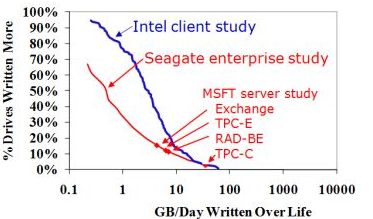Some SSD buyers select a drive solely based on performance, some make their decision based on price and others buy for combinations of these and other factors. But almost all SSD buyers are confused by a single issue that could soon see a tremendous increase of clarity, "How long will my SSD last?"
SSD Endurance
This question gets to the root of what’s called SSD endurance. To oversimplify the issue, SSDs have a finite expected lifespan that can be determined by counting the total amount of data written to the SSD, also referred to as TBW, terabytes written.
Of course SSDs can fail because of physical issues as well, anything with integrated circuits can have a flaw that causes failure when the circuits are under stress over some period of time. The good news with hardware failures is that they generally occur quickly and under warranty.
Given as SSD users, we can’t do anything about predicting or preventing a hardware circuitry failure, we have to focus attention on what we can control, or at least monitor. That brings us back to TBW and understanding how that effects the longevity of an SSD.
Unfortunately, while standardization is in the works for client SSDs (think end users, not enterprise), presently there’s not a great way for users outside of Intel SSDs, and a few others, to measure the TBW on their SSD. Worse yet, even if you had this data, most manufacturers aren’t publishing their TBW threshold (Western Digital is an exception and Intel claims 5 years of SSD life with 20GB host writes per day), so it’s problematic to know what portion of the SSD is remaining.
There are two silver linings though: first, most users will never reach the TBW threshold and second, standardization is coming.
Measuring SSD Writes
At Intel’s 2010 developer forum they made a presentation on SSD endurance and discussed results of a client study that showed most of us actually write very little data. Most users fall around 5GB/day while only a single digit percentage breach the 50GB/day mark. To use round numbers, this means if you have a 100GB SSD, you would rewrite the drive fewer than 1000 times in five years, even if you’re a heavy 50GB/day user. For most SSD users, this data alone should be comforting, but there’s more to come to help users understand the lifespan of their SSD.

The future is going to come through an open standards group, JEDEC. JEDEC has already defined the enterprise SSD standards and are working toward an endurance standard for client SSDs as well. The net result is exciting – those manufacturers who participate will end up with published results on the expected TBW for their drives.
What consumers should hope to expect is a fuel gauge style readout that shows the drive’s rated TBW cap and the actual TBW. This exceedingly simple interface will go a long way to assuage SSD user’s concerns regarding drive endurance.
Going Forward
This forthcoming endurance data will be a spec sheet line item, one more meaningful than the current mean time between failure (MTBF) measure, that when combined with read/write speed ratings and independent reviews will help consumers make the proper buying decisions. Based on the number of questions we receive at StorageReview.com via emails and forums, this type of consumer actionable data can’t come fast enough.




 Amazon
Amazon